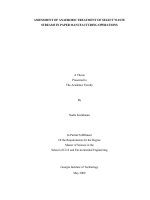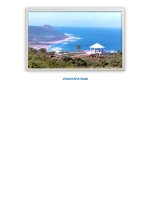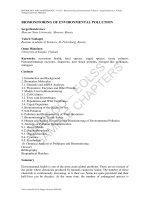Example of environmental treatment exam
Bạn đang xem bản rút gọn của tài liệu. Xem và tải ngay bản đầy đủ của tài liệu tại đây (307.06 KB, 6 trang )
United Arab Emirates University
College of Engineering
Dept. Civil & Env. Eng.
Name______________________
Student ID#________________
CIVL375: Water and Wastewater Technology
2nd Semester 05-06
Section 1
Mid-Term Exam
Max. Grade 20
Time 1:15
1. (3.0 pts) This problem is related to the schematic below which shows a flow
diagram of a domestic wastewater treatment plant. Select the correct answer
Wastewater
BS
TS
GC
AT
PS
SS
Chlorine
Treated
wastewater
CT
F
BS=bar screen
AT=aeration tank
CT= contact tank
AC
TS= traveling screen
GC= grit chamber
SS= secondary settling tank F= filtration
PS=primary settling tank
AC= activated carbon
a. The type of particle settling encountered in the grit chamber is (are)
(i) Type I settling
(ii) Type II settling
(iii) Type III settling
(iv) Type III and IV settling
b. The type of particle settling encountered in the primary settling tank is (are)
(i) Type I settling
(ii) Type II settling
(iii) Type III settling
(iv) Type III and IV settling
c. The type of particle settling encountered in the secondary settling tank is (are)
(i) Type I settling
(ii) Type II settling
(iii) Type III settling
(iv) Type III and IV settling
d. The objective of aeration in the aeration tank is to
(i) increase dissolved oxygen
(ii) reduce the pH
(iii) remove undesirable gases
(iv) increase the pH
e. The activated carbon reactor shown is designed as a
(i) batch reactor
(ii) plug flow reactor
(iii) continuous-stirred tank reactor
(iv) packed bed reactor
f. If the primary settling tank of this treatment plant is 12-ft deep and the tank receives
a flow rate of 2 million gallon per day. The minimum weir length that should be
provided for this tank is:
(i) 10000 ft
(ii) 100 ft
(iii) 12 ft
(iv) 0.01 ft
2. (1.5 pts.) In the design of a wastewater treatment plant, the quality of the effluent
and the capacity of the plant are basic requirements for the design. On what basis each
of these two requirements is determined?
3. (2.0 pts.) The US EPA states that “bacterial quality criteria for drinking water from
public supplies require not more than 1 total coliform/100 ml as the arithmetic mean
of all water samples examined per month, with no more than 4 coliforms/100 ml in
any sample if the number of samples is ≤ 20/month or no more than 4 coliforms/100
ml in 5% of the samples if the number of samples exceeds 20/month".
The effluent of a water treatment plant that serves 15,000 people was sampled at
regular intervals over a month period for coliform testing and the results are shown in
the table below:
Sample number
Coliforms/100 ml
1
1
2
0
3
3
4
0
5
0
6
0
7
5
8
0
9
2
10
1
11
0
12
1
13
1
14
0
15
0
16
0
Based on the above results, are the number of samples tested and the effluent bacterial
quality acceptable? Explain.
4. (3.0 pts) The cumulative volume of water consumption of a residential town that
has 90,000 is presented below. An elevated water tank is to be built so that water is
pumped from a water treatment plant at a constant rate to the tank and is then
transferred by gravity to the residents.
Cummulative flow, million gallon
8
6
4
2
0
0
4
8
12
16
20
24
T ime, hr
a. (2.0 pts) What is the design capacity of the storage tank?
b. (0.5 pts) What is the pumping rate from the water treatment plant into the tank?
c. (0.5 pts) Based on the given data, what is the average daily per capita water
consumption in the town?
5. (2.5 pts) What detention time is needed to remove 99% of a contaminant in a plug
flow reactor with a reaction rate constant of 1.5 per day?
6. (3 pts) A sedimentation tank 3.5-m deep has a flow-through velocity of 4 m/hr and
an over-flow rate of 0.92 m3/(hr.m2). What is the length of the tank?
7. (2.0 pts) A secondary settling tank is 4-m deep and receives a flow rate of 7400
m3/day with suspended solids concentration of 2,200 mg/l.
a. (1 pts) What would be the sludge depth in the tank for a settled sludge with a
suspended solids concentration of 12,000 mg/l?
b. ( 1 pts) If the detention time required to reach the solids concentration in part a is 1
hr, what is the surface area needed to achieve this?
0
8. (3.0 pts). Using settling trajectories determined by the settling column analysis
shown in the figure below, find the overall percent removal for a settling basin 3.0-m
deep with a settling time of 30 minutes. Note that solid lines indicate percent removal
of suspended solids.
0.5
75%
1.0
60%
1.5
Depth (m)
2.0
15%
30%
45%
2.5
3.0
10
20
30
Time (min)
40
50
60
POTENTIALLY USEFUL INFORMATION
GLUMRB Recommendations
Rapid mixing:
Detention time≤ 30 sec
Slow mixing (flocculation):
Detention time > 30 min
Velocity through tank= 0.5-1.5 ft/min
Paddle velocity= 0.5-3 ft/sec
Sedimentation:
Detention time ≥ 4 hrs
Velocity through tank ≤ 0.5 ft/min
Weir loading≤ 20,000 gpd/ft
Over-flow rate= 500-800 gpd/ft2
C
1
=
C o 1 + k (V / Q)
C
= e − k (V / Q )
Co
4kt R
a = 1 +
Pe
C
4ae ( Pe / 2)
=
Co (1 + a ) 2 e ( aPe / 2 ) − (1 − a ) 2 e ( − aPe / 2)
∑ tC
t=
∑C
C o H o = Cu H u
∑t C − t
=
∑C
2
σ2
v=
Q
Ax
2
σ θ2 =
σ2
t2
vo =
Q
As
0.5
and Pe = uL/D
σ θ2 = 2
Ac =
Q
vo
D
D
− 2( ) 2 (1 − e −uL / D )
uL
uL
At =
Q × tu
Ho
Number of samples taken for coliform testing based on population served by treatment facility









